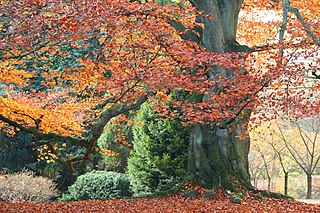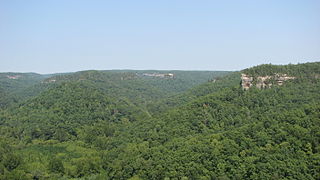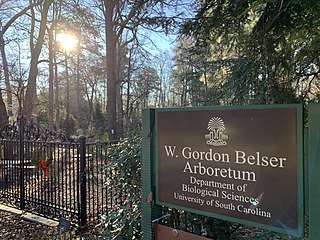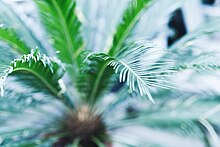
Beech (Fagus) is a genus of deciduous trees in the family Fagaceae, native to temperate Eurasia and North America. There are 13 accepted species in two distinct subgenera, Engleriana and Fagus. The subgenus Engleriana is found only in East Asia, distinctive for its low branches, often made up of several major trunks with yellowish bark. The better known Fagus subgenus beeches are native to Europe and North America. They are high-branching trees with tall, stout trunks and smooth silver-grey bark. The European beech Fagus sylvatica is the most commonly cultivated species, yielding a utility timber used for furniture construction, flooring and engineering purposes, in plywood, and household items. The timber can be used to build homes. Beechwood makes excellent firewood. Slats of washed beech wood are spread around the bottom of fermentation tanks for Budweiser beer. Beech logs are burned to dry the malt used in some German smoked beers. Beech is also used to smoke Westphalian ham, andouille sausage, and some cheeses.

Fagus sylvatica, the European beech or common beech is a large, graceful deciduous tree in the beech family with smooth silvery-gray bark, large leaf area, and a short trunk with low branches.

The H. H. Hunnewell estate in Wellesley, Massachusetts was the country home of H. H. Hunnewell (1810–1902), containing over 500 species of woody plants in 53 families. The estate remains in the family, and includes the first (1854) topiary garden in the United States, featuring intricate geometrically clipped native Eastern white pine and Eastern arborvitae. A collection of specialty greenhouses feature over 1,000 plant species. The estate has been cared for by six generations of the Hunnewell family.

The Sister Mary Grace Burns Arboretum, on the campus of Georgian Court University, in Lakewood Township, New Jersey, United States, was once the landscaped park for the winter home of George Jay Gould, millionaire son of railroad tycoon Jay Gould.
The George Landis Arboretum is a public garden comprising hundreds of acres of which 40 are devoted to noteworthy collections and gardens overlooking the Schoharie Valley near Esperance, New York, United States. The physical address is 174 Lape Road. Forty acres of the Arboretum are developed with plantings of trees, shrubs, and herbaceous perennials from around the world, including approximately 2,000 labeled specimens. The remainder of the property consists of natural areas, woodlands, wetlands, more than 8 miles of trails, and open fields. Among the Arboretum's horticultural features are a labeled collection of nearly all the trees, shrubs and vines native to New York State, as well as collections of notable trees, flowering ornamental trees and shrubs, tough trees for tough sites, conifers, and oaks. Two old growth forests and additional natural areas representing various stages of succession await visitors The Van Loveland Perennial Garden at the old farmhouse is a seasonal favorite. Collection signage includes QR codes directed toward audio descriptions.

The University of Delaware Botanic Gardens are botanical gardens and an arboretum located on the campus of the University of Delaware, in Newark, Delaware, United States. The gardens are open to the public without charge.
The University of Rochester Arboretum is an arboretum located across the River Campus of the University of Rochester, 612 Wilson Boulevard, Rochester, New York.

Skylands is a 1,119-acre (4.53 km2) estate property located in Ringwood State Park in Ringwood, New Jersey, a borough in Passaic County in the state of New Jersey. The Skylands property consists of the historic Skylands Manor mansion, The Castle at Skylands Manor and the New Jersey Botanical Garden; the botanical garden is 96 acres (390,000 m2) and it is open to the public year-round. The Skylands property is within the Ramapo Mountains and it is maintained by the Skyland Association. The property is marketed with the garden as New Jersey State Botanical Garden at Skylands.

Nichols Arboretum, locally known as the Arb, is an arboretum on the campus of the University of Michigan, in Ann Arbor, Michigan. The Arb is located adjacent to the Huron River, and features over 400 species, including 110 species of trees, in a varied, hilly landscape. A signature feature of Nichols Arboretum is the W. E. Upjohn Peony Garden, which features the largest collection of heirloom peonies in North America.

The Morris Arboretum & Gardens of the University of Pennsylvania is the official arboretum of the Commonwealth of Pennsylvania. The Arboretum is open daily except for major holidays. It is located at 100 East Northwestern Avenue, Chestnut Hill, Philadelphia, Pennsylvania.

Daniel Boone Native Gardens, located in Boone, North Carolina, United States, has a collection of North Carolina native plants in an informal landscaped design. The gardens are open daily from May to October.

The Appalachian mixed mesophytic forests is an ecoregion of the temperate broadleaf and mixed forests biome, as defined by the World Wildlife Fund. It consists of mesophytic plants west of the Appalachian Mountains in the Southeastern United States.

W. Gordon Belser Arboretum is part of the University of South Carolina in Columbia, South Carolina, managed by the Department of Biological Sciences. The arboretum serves as a nature preserve, field laboratory and research site for students and faculty. It is open to the public at a monthly open house. A small botanic garden features shrubs and small trees suitable for Columbia's home landscapes. The remaining landscape features southeast native trees and plant communities and is a certified Palmetto Wildlife Habitat.
The Museo e Arboreto Carlo Siemoni is a museum and historic arboretum located in Badia Prataglia, Poppi, Province of Arezzo, Tuscany, Italy.
The Arboretum d'Amance is an arboretum located in Champenoux, Meurthe-et-Moselle, Lorraine, France. It is managed by the Centre INRA de Nancy, a branch of the Institut National de la Recherche Agronomique (INRA), and open on the third Saturday of the warmer months; an admission fee is charged.

Wojsławice Arboretum is an arboretum, located in Wojsławice, Dzierżoniów County, Lower Silesian Voivodeship, in south-western Poland. It occupies an area of 62 ha.

The weeping beech, Fagus sylvatica 'Pendula', is a cultivar of the deciduous European beech. The original tree was found in the grounds of an English park, and it has been propagated by grafting, then many distributed widely.

Weeping trees are trees characterized by soft, limp twigs. This characterization may lead to a bent crown and pendulous branches that can cascade to the ground. While weepyness occurs in nature, most weeping trees are cultivars. Because of their shape, weeping trees are popular in landscaping; generally they need a lot of space and are solitary so that their effect is more pronounced. There are over a hundred different types of weeping trees. Some trees, such as the cherry, have a variety of weeping cultivars. There are currently around 550 weeping cultivars in 75 different genera, although many have now disappeared from cultivation.

The Wellesley College Botanic Gardens are botanical gardens located on the campus of Wellesley College in Wellesley, Massachusetts. The greenhouses and 22 acres of outdoor gardens include thousands of plants representing over 1,500 different taxa from more than 150 different plant families.



















